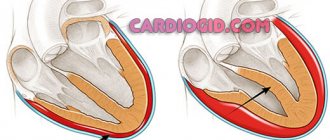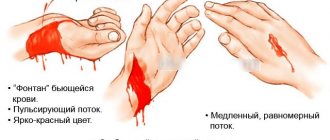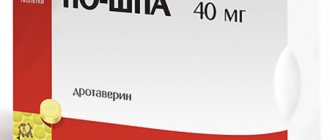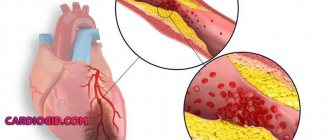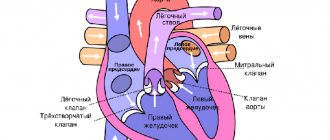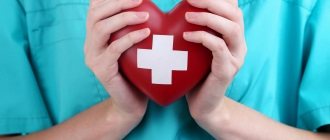Recently, the number of diseases affecting the cardiovascular system has increased significantly. This is due to a passive lifestyle, poor diet, alcohol and nicotine abuse, and hereditary predisposition. First aid for a heart attack and heart pain must be provided correctly, since this condition poses a great danger to a person.
What is a heart attack
The heart is an important organ for the human body, which works 24 hours a day and 7 days a week. This organ has a complex structure and performs vital functions. Any pathological changes affecting the cardiovascular system are dangerous. Disturbances in the structure and functioning of the vascular-cardiac system require professional medical treatment.
The term “heart attack” (myocardial infarction) in the medical community refers to pathological disorders that arise due to poor and insufficient blood supply to the heart muscle. More often, this pathology occurs due to the fact that for some reason the blood vessels supplying the heart with blood become clogged. In the future, ischemia and necrosis of areas of the heart muscle may develop.
Topic pages > Important to know > First aid for a heart attack
First aid for a heart attack
Characteristic signs (symptoms) of a heart attack (myocardial infarction):
- sudden (paroxysmal) pressing, squeezing, burning, aching pain in the chest (behind the sternum), lasting more than 5 minutes;
- similar pains are often observed in the area of the left shoulder (forearm), left shoulder blade, left half of the neck and lower jaw, both shoulders, both arms, the lower part of the sternum along with the upper abdomen;
- lack of air, shortness of breath, severe weakness, cold sweat, nausea often occur together, sometimes following or preceding discomfort/pain in the chest;
- Often these manifestations of the disease develop against the background of physical or psycho-emotional stress, but more often with some interval after them.
Uncharacteristic signs that are often confused with a heart attack:
- stabbing, cutting, pulsating, boring, constant aching pain for many hours and not changing its intensity in the heart area or in a specific clearly defined area of the chest.
Algorithm of urgent actions:
If you or someone else suddenly has the above characteristic signs of a heart attack, even with weak or moderate intensity, which last more than 5 minutes, do not hesitate, immediately call an ambulance team.
Do not wait more than 10 minutes - in such a situation it is life-threatening!
If you have symptoms of a heart attack and there is no way to call an ambulance, then ask someone to take you to the hospital - this is the only right decision. Never drive yourself unless you have no other choice.
The best option is to follow the instructions from your doctor if you have a heart attack.
If there is no such instruction, then you must act according to the following algorithm:
- call an emergency medical team;
- sit down (preferably in a chair with armrests) or lie down in bed with the head of the bed raised, take 0.25 g of acetylsalicylic acid (aspirin) (chew the tablet, swallow) and 0.5 mg of nitroglycerin (put the tablet/capsule under the tongue, first bite the capsule, do not swallow); free your neck and provide fresh air (open the vents or windows);
- if after 5-7 minutes. after taking acetylsalicylic acid (aspirin) and nitroglycerin, the pain persists, you need to take nitroglycerin a second time;
- if 10 minutes after taking the second dose of nitroglycerin the pain persists, it is necessary to take nitroglycerin for the third time;
- if after the first or subsequent doses of nitroglycerin there is severe weakness, sweating, shortness of breath, you need to lie down, raise your legs (on a bolster, etc.), drink 1 glass of water and then, as with a severe headache, do not take nitroglycerin again;
- if the patient has previously taken medications that lower blood cholesterol levels from the statin group (simvastatin, lovastatin, fluvastatin, pravastatin, atorvastatin, rosuvostatin), give the patient his usual daily dose and take the drug with you on the road.
ATTENTION!
A patient with a heart attack is strictly prohibited from:
get up, walk, smoke and eat
until special permission from the doctor;
Do not take aspirin (acetylsalicylic acid) if
intolerance to it (allergic reactions), as well as with obvious exacerbation of gastric and duodenal ulcers;
Nitroglycerin should not be taken if
severe weakness, sweating, as well as severe headache, dizziness, acute impairment of vision, speech or coordination of movements.
AMBULANCE CAN BE CALLED:
from a landline phone (landline, home) by numbers 03
or
103;
from a mobile phone (any operator) - by single number 103.
Based on materials from methodological recommendations approved by the chief specialist in preventive medicine of the Ministry of Health of the Russian Federation.
www.gnicpm.ru
Other materials
What to do in case of a heart attack First aid for acute cerebrovascular accident How to recognize a stroke?
Heart Attack Symptoms
To quickly identify a pathology, you need to know its symptoms. Doctors identify characteristic and uncharacteristic signs.
Typical symptoms include:
- Sharp pain in the chest area. It is pressing, squeezing, burning, aching in nature and lasts longer than 5 minutes.
- The pain symptoms described above can also be localized in the area of the left shoulder/forearm, in the left half of the neck and face.
- Victims also complain of a lack of oxygen, dyspnea, cold sweat, and an unpleasant and uncomfortable feeling in the chest.
- A typical feature is psycho-emotional symptoms, which are expressed in the form of panic and fear of death.
Atypical signs of myocardial infarction include many hours of painful symptoms of a cutting, pulsating, aching nature in the heart area.
In medicine there is also such a term as “silent heart attack”. In this case, we are talking about a heart attack that occurs in patients whose age category exceeds 75 years. These patients also have diabetes mellitus. In this case, the heart attack is completely asymptomatic. Only 1/5 of “silent heart attacks” are diagnosed on time. Basically, they find out about it after a certain period of time during a routine inspection.
"Non-heart" syndromes
There are many factors that cause people to experience pain that mimics cardiac dysfunction.
Let's look at the most common of them.
- Neuralgia and osteochondrosis
In these diseases, the appearance of pain is associated with certain provoking factors:
- Hypothermia;
- Staying in a static, uncomfortable position for a long time;
- Sudden lifting of a heavy object;
- Mechanical impact of heavy weights on the chest (bruise, fracture).
Note!
With osteochondrosis, the symptoms are very similar to an angina attack.
A distinctive feature of pain with intercostal neuralgia and osteochondrosis is its intensity, which reaches its peak with inhalation or the slightest movement. In this case, the source of pain can be detected using palpation: it is particularly intense in the area of the ribs or along the spine.
- Pleurisy
Damage to the pleura may be due to the following reasons:
- Chest injury;
- Inflammatory process in the lungs;
- Allergic reaction.
Note!
To detect pleural plaque, you need to palpate the lower ribs on the right and left sides and compare them. On the left side you will clearly feel how it covers the lower part of the ribs.
The pain is especially severe if the pleura is covered with metastases formed after malignant tumors. The pain syndrome is constant, especially pronounced when coughing.
- Cardioneurosis
In addition to dull or stabbing pain in the left side of the sternum, the following signs clearly appear:
- Profuse sweating;
- Insomnia;
- Increased heart rate;
- Excitation;
- Hand trembling.
Note!
Stitching pain in the heart resulting from cardioneurosis cannot be relieved by “heart” medications.
- Diseases of the gastrointestinal tract
It is not difficult to distinguish pain in the heart area in these diseases. They are always accompanied by the following characteristic signs:
- Heartburn;
- Vomiting;
- Abnormal stool;
- Nausea;
- Severe bloating.
The pain syndrome is shingles in nature and is directly related to a violation of the diet.
- Pulmonary embolism
A dangerous disease in which a person has to deal with the following manifestations:
- Dyspnea;
- Tachycardia;
- Anxiety;
- Fainting state.
The pain syndrome is sharp, paroxysmal. Intensifies during deep breathing or coughing attacks.
Your doctor will tell you what to do if you have pain in the heart area after a detailed examination. All of these diseases are dangerous for humans, so you cannot postpone a visit to professionals.
First aid algorithm for a heart attack
If symptoms of a heart attack occur, it is recommended to quickly provide first aid using the following algorithm:
- In the first minutes, call an ambulance.
- The patient should take a sitting or lying position, raising his head.
- Then the patient should take 0.25 grams of acetylsalicylic acid, the medication must first be chewed and then swallowed. After taking the medicine, you need to take 0.5 mg of Nitroglycerin sublingually, breaking the capsule in advance and allowing it to dissolve under the tongue.
- You should also take care to keep the patient calm and have enough oxygen (for example, open a window).
- If, 7 minutes after ingesting the drugs, the pain still does not go away, you should take a repeat dose of nitroglycerin.
- If 10 minutes after taking 2 doses of nitroglycerin the pain still does not disappear, you need to take the medication 3 times.
- If, after taking nitroglycerin, additional symptoms develop, which manifest themselves in the form of weakness, increased sweating, lack of air, pain in the head, then you need to stop taking this drug.
- If the victim takes cholesterol-lowering pills on a regular basis, it is advisable to have him take his daily dosage of the medication.
First aid
It is important to remember that the life and further recovery of the patient depend on timely first aid.
Algorithm of actions
- If an MI is suspected: the patient, if conscious, must be seated and reassured. The best positions: sitting, leaning on the back of a chair or armchair, reclining with knees bent. Provide access to fresh air; loosen tight, constricting clothing (bra for women, tie for men);
- Call an ambulance;
- If you have Aspirin or Nitroglycerin and the patient is not allergic to the drugs: Chew Aspirin (this speeds up the action of Aspirin) and swallow OR Put Nitroglycerin under the tongue (do not chew, do not swallow);
- In case of cardiac arrest (loss of consciousness, agonal breathing - shallow, frequent, with wheezing, lack of breathing), immediately begin CPR (cardiopulmonary resuscitation): place your hands in the center of the chest and begin performing chest compressions, followed by artificial respiration.
For reference
- Arriving medical personnel must be informed of the measures taken. For example, if a patient has been given a dose of Aspirin, then an additional dose is not required.
- If, after taking aspirin or nitroglycerin, the pain has disappeared, the condition has improved, it is still necessary to call a local physician at home. This cannot be ignored.
Cardiopulmonary resuscitation for heart attack
Cardiopulmonary resuscitation for myocardial infarction is resorted to only when signs of clinical death occur. Its main symptoms include:
- unconsciousness of the patient;
- absence of respiratory activity and jerky oscillations of arterial walls associated with cardiac cycles.
It is important to immediately call emergency help when the first clinical signs of death appear, if this has not been done before. Basic resuscitation includes:
- Indirect cardiac massage, which is performed at a speed of 100-120 compressions per 60 seconds, and at a depth of 5-6 cm.
- Also, if two people provide assistance, it is necessary to perform artificial ventilation, the ratio of compressions and breaths is 30 to 2.
- If it is not possible to perform artificial respiration, then it is necessary to continue performing cardiac massage without stopping.
Carrying out a mechanical ventilation procedure carries a risk of infection, therefore, in the absence of the necessary funds for its implementation, it is recommended to refrain from performing it.
Features of symptoms
In fact, a heart attack can happen to almost anyone. But the following people are at increased risk:
- With pathologies of the cardiovascular system;
- Older and older people. Men and women over 50 years of age are most often affected;
- Those who have a hereditary predisposition to this pathology;
- Having high levels of cholesterol in the blood;
- Suffering from diabetes;
- Suffering from arterial hypertension;
- Overweight;
- Leading a passive lifestyle;
- Those who abuse bad habits: cigarettes, alcohol;
- Often in stressful situations.
If a person has a heart attack, it will be visible to the naked eye. The main symptoms of this condition include:
- Stitching pain behind the sternum. It can spread to nearby areas: shoulders, face, neck, arms;
- Paleness of the skin;
- Dizziness;
- Sweat on the face;
- Severe shortness of breath;
- Nausea and sometimes vomiting;
- Increased anxiety, feeling of panic.
Dizziness is one of the symptoms of a heart attack.
The most important thing is to begin providing first aid immediately when these signs occur. The more time is lost, the higher the risk of death. Overall, the proportion of deaths due to heart attack is about 60%.
How to call an ambulance correctly
If initial signs of an attack appear, you should contact an ambulance. You need to dial 03. You need to briefly and clearly explain the current situation to the dispatcher.
First, you need to introduce yourself, name the age and gender (of the victim/your own), tell about the symptoms that have arisen and their duration. Why tell us what medications you took previously? You also need to give your address and ask what actions to take next before the specialists arrive.
Preventive measures
The basic direct preventive measure in the vast majority is complex drug therapy using antithrombotics, beta blockers, statins, polyunsaturated acids, unfractionated heparin, ACE inhibitors or other components of conservative treatment.
However, in this case we are talking about directly preventing relapses of the pathological process. As part of the general fight against the possibility of developing clinical manifestations of coronary heart disease, the following measures are taken:
- Body weight control. This is done by performing regular physical activity, correcting the diet;
- Rejection of bad habits. Smoking, alcoholism and drug use are recognized as particularly dangerous;
- Monitoring sugar levels and blood pressure. Required if there are predisposing circumstances;
- Correction of circadian rhythms. The main emphasis is on a healthy lifestyle.
What to prepare for the arrival of an ambulance doctor?
To make future work easier for emergency personnel, you should carefully prepare for their arrival:
- It is necessary to make a list of medications taken by the victim on a regular basis, and a list of those medications that he took when his complaints appeared.
- It is necessary to make a list of medications and/or substances to which the patient is allergic or intolerant.
- If there are results of previous diagnostics affecting the cardiovascular system, it is necessary to prepare them and show them to a specialist.
- You should collect documents and things required for the patient’s continued stay in the hospital.
Concept and causes of heart attack
First aid for a heart attack and timely calling an ambulance can save a person: most deaths from this disease occur in the first hours after the onset of symptoms.
A heart attack is a pathology that occurs as a result of an acute deficiency of blood supply to the myocardium. The cessation of the supply of nutrients and oxygen is most often associated with thrombosis or spasm of the area of the coronary artery near atherosclerotic plaques. Cardiac ischemia - a decrease in tissue supply due to weakening or complete cessation of blood flow - leads to its necrosis. This phenomenon is called myocardial infarction.
Characteristics of a heart attack include:
- Occurs during night sleep or early morning.
- Increased likelihood of development after psycho-emotional stress (funeral, stressful situation, conflict) and with an increase in blood pressure.
- The dependence of the risks of occurrence on the amount of physical exercise in the next few hours before the attack (chest pain can appear not only during exercise, but even at night after a busy day).
- Occurs when the body is dehydrated (being in a bathhouse, on a hot street or in a heated room, using diuretics) or in the next 12 hours after excessive consumption of alcoholic beverages.
Experts consider people at increased risk of having a heart attack for the following reasons:
- Blood pressure is more than 140/90 mm. Hg;
- Obesity;
- Diabetes;
- Ischemia and failure of the cardiovascular system;
- Increased concentration of low-density lipoproteins (LDL or “bad” cholesterol) and triglycerides in the blood with a decreased level of high-density protein-lipid compounds (HDL);
- Physical inactivity;
- Smoking and excessive alcohol consumption;
- Unfavorable environmental conditions;
- Age over 40 for men and over 50 for women.
First aid for heart pain
Here's how to act if a pain symptom appears in a person's heart:
- First of all, call an ambulance.
- It is recommended to take care of the supply of a sufficient amount of oxygen, calm the patient, make sure that he takes a position that is comfortable for him, and unbutton the buttons on his outerwear.
- Then (if there are symptoms specific to a heart attack), the patient should be given 0.25 g of aspirin and 0.5 mg of nitroglycerin.
What to do when no one is around?
The most dangerous option is considered if during an attack there is not a single person nearby who could help. Unfortunately, not many people know what to do if they have a heart attack in this case.
The most important thing is to remain calm. Panic will only make matters worse. Here's what to do:
- Call an ambulance. If there is no telephone nearby, you should try to go outside and ask people to call an ambulance or take you to the nearest hospital;
- Open the window to allow fresh air into the room;
- Loosen all tight parts of clothing: unfasten the buttons on the collar and cuffs, remove the belt. Bracelets, watches, and rings can also be removed if they cause uncomfortable pressure;
- Take medicine. First, swallow an Aspirin tablet, after chewing it, and then place half or one whole Nitroglycerin tablet under the tongue.
- Take a comfortable position, but so that the level of your head is higher than the level of your feet. For example, you can sit in a chair or lie down in bed and put a high pillow under your head. A bed with a high headboard is also perfect;
- If after 6-8 minutes it does not become easier, then you need to once again put a Nitroglycerin tablet under your tongue and again take a comfortable position;
- It is possible to take another dose of Nitroglycerin if the situation does not improve after 10 minutes.
If no one is around during a heart attack, you need to remain calm and take a nitroglycerin tablet.
During this time, an ambulance team should arrive to provide professional assistance and alleviate the condition.
If no medications are available, then the best thing the victim can do is call an ambulance and take the indicated position. There is no need to get up and move around.
First aid for acute myocardial infarction
The term “acute myocardial infarction” refers to the initial phase of this pathological manifestation. Its duration is 120 minutes from the onset of the first symptoms.
If symptoms typical of myocardial infarction suddenly appear, you need to call emergency help as quickly as possible, as this will further avoid unwanted complications and death.
First aid algorithm:
- The patient must take a position that is comfortable for him, lying with his head elevated or sitting.
- Then you need to take aspirin and Nitroglycerin, open the windows, unfasten the buttons on outer clothing, and make sure that the patient calms down. Next, monitor his well-being and adhere to the sequence of actions described above.
- In case of panic, you can give the patient sedatives such as Validol or Corvalol.
Learning to recognize myocardial infarction (MI) ❗
Acute heart failure is characterized by squeezing, tearing pain in the depths of the chest, radiating to the upper limbs, neck, involving the lower jaw, between the shoulder blades, and less often to the solar plexus; can even radiate to the back of the head. The pain is accompanied by weakness, sweating (cold and sticky sweat), nausea, and dizziness.
Pain is not always present! In approximately 15-20% of patients, acute myocardial infarction is painless. More often, silent MI is observed in patients with diabetes mellitus, as well as in the elderly. In elderly patients, MI is expressed by sudden shortness of breath, which can develop into pulmonary edema. In other cases, MI, both painful and silent, is characterized by a sudden loss of consciousness, a feeling of severe weakness, the occurrence of arrhythmia, or simply an unexplained sharp decrease in blood pressure.
First aid for angina
The symptoms of angina attacks are almost identical to those of a heart attack. An attack of angina pectoris lasts a maximum of a quarter of an hour and manifests itself during active physical activity/stress.
If the victim sits down and stops physical activity, the complaints go away after a short period of time. If such symptoms are observed, it is recommended to make an appointment with your family doctor or cardiologist as soon as possible for further diagnosis.
If pain symptoms last more than 20 minutes, then it is customary to talk about myocardial infarction. If an attack of angina occurs, it is also recommended to take Nitroglycerin; after a short period of time after taking the medication, complaints and symptoms disappear.
Symptoms of myocardial infarction
The main symptom of a heart attack is pain in the chest, which is quite reminiscent of an angina attack. In this case, the syndrome is more intense.
Also, depending on the severity of myocardial infarction and the overall clinical picture, secondary manifestations may be observed, especially against the background of fairly strong physical activity, stress, excessive alcohol consumption, smoking, drugs, overeating, and so on.
Among women
As modern clinical practice shows, subjective symptoms in women manifest themselves less intensely than in the stronger sex.
Pathological processes start with a pain syndrome and develop gradually, while the pain does not weaken, but increases over tens of minutes and even several hours. Directly with the pain, profuse cold sweat and subjective fears, including those about a possible death, are formed.
In men
Representatives of the stronger sex most often quickly diagnose the onset of a pathological process in the form of a pain syndrome, which at first resembles angina pectoris, but radiates not only to the sternum, but also to the neck or left shoulder.
In this case, the pain itself can increase either gradually or appear suddenly. Also, characteristic signs of myocardial infarction are:
- Pallor of the skin. Mainly reflex type;
- Feeling of partial numbness in the fingers of the upper and lower extremities;
- Sweat . The substance itself is abundantly sticky and cold, appears quickly and dries just as intensely;
- Shortness of breath and loss of consciousness. Most often diagnosed with severe circulatory disorders. The first symptom quickly turns into a non-productive dry cough and pulmonary edema in the absence of qualified assistance. The second symptom is associated primarily with hypoxia or cardiac arrest, requiring emergency resuscitation.
Prevention of heart pain
There are also a number of rules that will help reduce the risk of cardiovascular diseases, and in the future the appearance of heart pain.
- It is recommended to lead a healthy lifestyle, play sports, strengthen your body, and strengthen your immune system.
- You need to watch your diet and give preference to fresh vegetables and fruits. Avoid fast food, fatty and spicy foods.
- You need to monitor your weight. If your weight exceeds the norm, you need to exercise and watch your diet.
- If you have chronic diseases affecting the cardiovascular system, as well as endocrine diseases, you must regularly take medications prescribed/recommended by your doctor.
- If you have a genetic predisposition to heart pathologies, you should tell your doctor about it. It is important to undergo regularly scheduled diagnostic examinations.
- It is also recommended to get rid of bad habits, stop drinking and smoking.
To avoid unwanted consequences and complications after a heart attack, you need to recognize the symptoms of the disease in time and promptly seek professional help. According to statistics, many patients who experience a heart attack die within 60 minutes if they do not receive first aid.
Causes of chest pain
The source of pain in the chest can be all its organs.
It is important to correctly identify a heart attack. But what if the symptoms are subtle? Below is a table that outlines the most common causes of chest pain. Causes
| Localization | Nature of pain | Factors that provoke, enhance, relieve | Some associated symptoms | |
| Angina pectoris | retrosternal, can radiate to the neck, lower jaw, upper extremities, stomach area | pressing, burning, squeezing; lasting up to 10 minutes | exercise stress; stops after removing the load or taking nitroglycerin | dyspnea |
| Myocardial infarction | retrosternal, can radiate to the neck, lower jaw, upper extremities, stomach area | squeezing, tearing pain in the depths of the chest; pain more intense than with angina pectoris; | is not relieved by taking nitroglycerin and does not stop after eliminating the load | shortness of breath, increased sweating (cold and sticky sweat), severe weakness, nausea, occasional vomiting |
| Pericarditis | retrosternal or at the site of the apical impulse (rhythmic pulsation - a small protrusion within one intercostal space); may radiate to the neck and left shoulder | sharp, stabbing; intensity varies | deep breath, turning the body in different directions, lying down, coughing; decreases in a sitting position when bending forward | pericardial friction rub, shortness of breath |
| Cholelithiasis | right hypochondrium or stomach area, may radiate to the right shoulder | strong, increasing, then constant; fades away slowly; duration from 10 minutes to several hours | eating fatty foods; decreases when lying on your side | heartburn, nausea, vomiting, lack of appetite |
| Peptic ulcer | stomach area, rarely in the lower chest | dull, less often sharp | eating (sometimes on an empty stomach), | quick feeling of fullness, fullness of the stomach while eating |
| Osteoarticular pain | local, anterior chest wall | sharp or pressing | chest movements, cough | sensitivity to palpation |
| Neurotic pain | anterior chest wall | changeable | emotional stress | shortness of breath, palpitations, anxiety |
| Aortic dissection (very rare pathology) | anterior wall of the chest, extends to the interscapular or lumbar region | tearing, incredibly strong; appears suddenly | high blood pressure | asymmetry of blood pressure in the extremities |
| Esophageal rupture (very rare pathology) | retrosternal | very strong, burning; sudden | sudden vomiting | vomit |


